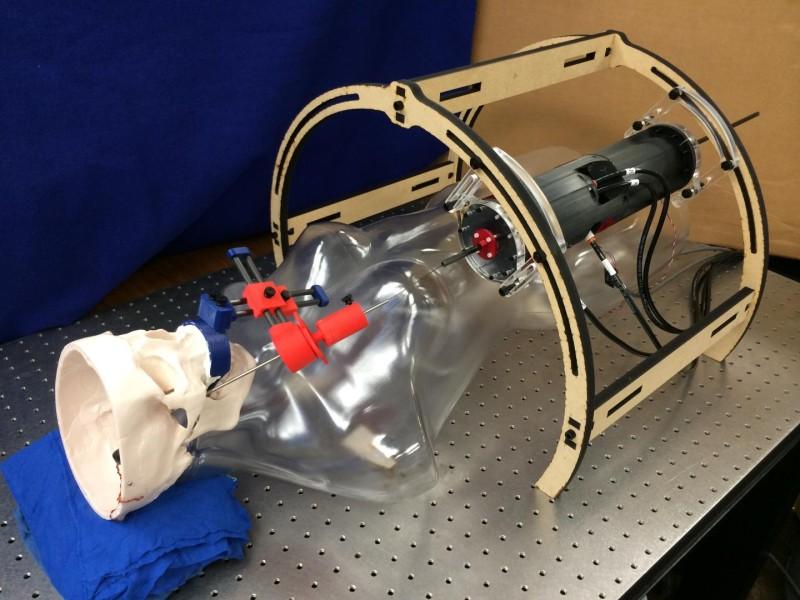
David Comber (left) and Eric Barth (right) with some of their robot’s 3D printed components
3D printing and robotics once prove a compatible and, potentially, a profoundly life-altering duo. The brainchild of Vanderbilt University engineering graduate student David Comber and mechanical engineering Associate Professor Eric Barth, a new robot has been designed to perform a delicate surgical procedure. The new robot was demonstrated this month at the Fluid Power Innovation and Research Conference in Nashville.
Developed over the course of five years and now moving into an extensive testing phase (starting with cadavers), the robot was designed specifically to be manufactured in part through the use of 3D printing, which will make it far less expensive to produce. In collaboration with Comber and Barth, Jonathon Slightam and Vito Gervasie of the Milwaukee School of Engineering developed the 3D printable design aspects of the robot. For some of the technical aspects of the robot, Comber and Barth consulted with colleagues at Vanderbilt, including faculty members in the mechanical engineering and neurosurgery departments. With cadaver testing on the near horizon, Barth is hopeful that the surgical robot could be active in surgeries within the coming decade, helping to relieve epilepsy patients’ symptoms.
The device was designed to perform surgery on the brains of epilepsy patients, for whom medication is only a partial solution in controlling seizures. Medication sometimes fails to help at all, making surgery a more compelling option, despite its seriously invasive nature. This is where the 3D printed surgical robot comes in. The current surgery requires removing a section of the patient’s brain or, at the least, stimulating or disconnecting it from neighboring tissue. The recovery process can be long and difficult after such a procedure.
The targeted portion of the brain, the area that is thought to be involved in epileptic seizures, is the hippocampus. It is located in the lower portion of the brain and is difficult to access. With the robotic device, the surgery can take place by inserting the needle into the patient’s cheek through gaps in the bone, which is a much shorter route to the hippocampus, an alternative that eliminates the need to drill through the patient’s skull.
The robot, which is designed to operate from within an MRI machine, thereby facilitating visibility throughout the procedure, is made from a variety of materials, including a shape-memory alloy for the surgical needle itself. In essence, the material can be deformed and then “remember” its original shape and be restored to it when it is heated. The specific alloy is nickel titanium, which is compatible with the MRI machine. Most other parts of the surgical robot are designed to be 3D printable, keeping costs low and designs consistent. Let’s hear your thoughts on yet another medical advance thanks to 3D printing. Discuss in the 3D Printed Medical Bot forum thread on 3DPB.com.
Subscribe to Our Email Newsletter
Stay up-to-date on all the latest news from the 3D printing industry and receive information and offers from third party vendors.
You May Also Like
3D Printing News Unpeeled: A $3000 SLS System, Construction Subsidies and Parameters
The Housing Affordability Crisis is one of Canadian President Trudeau’s biggest issues. Now the government has made subsidies available, including scaling new technologies, 3D printed housing and libraries of reapproved...
“Bundled Light” Enables High Quality Plastic 3D Printing from LEAM
Naturally, we expect current 3D printing methods to continuously improve, but it continues to do so in the most surprising ways. The latest development comes from LEAM, a startup spun...
Each to Their Own: Exploring Creality’s Latest Ender Trio as the Company Strengthens Its Commitment to 3D Printing Advocacy
Creality has reaffirmed its commitment to promoting 3D printing. The launch of the Ender-3 V3 SE, Ender-3 V3 KE, and Ender-3 V3 showcases the company’s dedication to catering to diverse...
3D Printing News Briefs, March 23, 2024: AM in the US Coast Guard, Navy, & More
In today’s 3D Printing News Briefs, we’re discussing the use of 3D printing in various branches of the military, including the U.S. Coast Guard, the U.S. Navy, and the German...
































